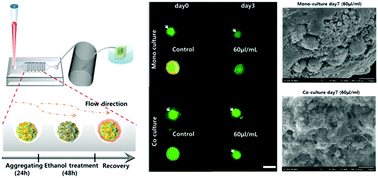A 3D alcoholic liver disease model on a chip†
Abstract
Alcohol is one of the main causes of liver diseases, and the development of alcoholic liver disease (ALD) treatment methods has been one of the hottest issues. For this purpose, development of in vitro models mimicking the in vivo physiology is one of the critical requirements, and they help to determine the disease mechanisms and to discover the treatment method. Herein, a three-dimensional (3D) ALD model was developed and its superior features in mimicking the in vivo condition were demonstrated. A spheroid-based microfluidic chip was employed for the development of the 3D in vitro model of ALD progression. We co-cultured rat primary hepatocytes and hepatic stellate cells (HSCs) in a fluidic chip to investigate the role of HSCs in the recovery of liver with ALD. An interstitial level of flow derived by an osmotic pump was applied to the chip to provide in vivo mimicking of fluid activity. Using this in vitro tool, we were able to observe structural changes and decreased hepatic functions with the increase in ethanol concentration. The recovery process of liver injured by alcohol was observed by providing fresh culture medium to the damaged 3D liver tissue for few days. A reversibly- and irreversibly-injured ALD model was established. The proposed model can not only be used for the research of alcoholic disease mechanism, but also has the potential for use in studies of hepatotoxicity and drug screening applications.


 Please wait while we load your content...
Please wait while we load your content...